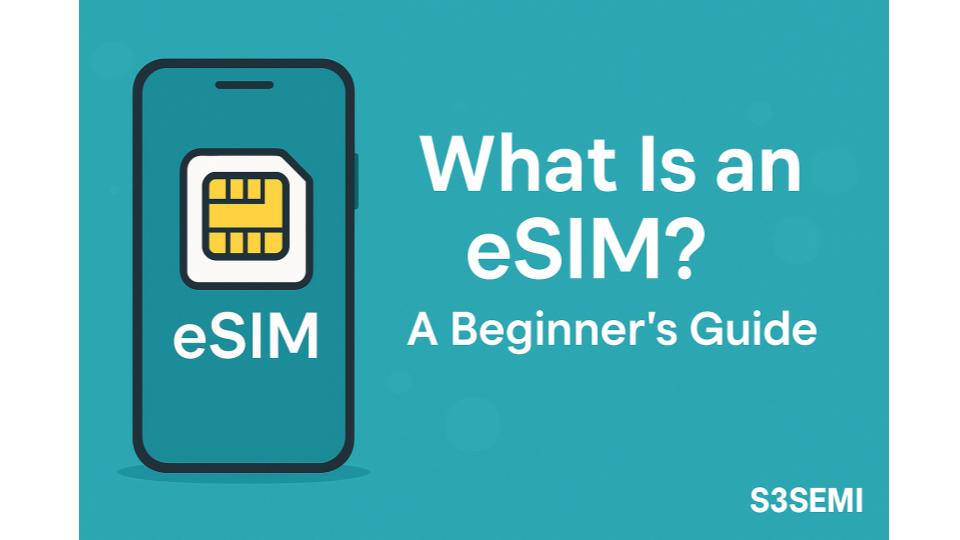📱 If you’ve ever inserted a tiny SIM card into your phone, you’re already familiar with how mobile networks connect to your device. But now, there’s a new, smarter way to stay connected – the eSIM.
Whether you’re a frequent traveler or just curious about how the tech works, this article breaks down what eSIMs are, how they work, and what you should know about billing, activation, and international use.
💡 What Is an eSIM?
eSIM stands for embedded SIM. Unlike traditional plastic SIM cards, an eSIM is built directly into your phone or device. It does everything a physical SIM does – it stores your carrier profile, phone number, and connects you to the mobile network – but it does so digitally.
That means:
- No more swapping SIM cards.
- You can have multiple plans on one device.
- You can activate a new plan instantly, even without visiting a store.

📲 How Does an eSIM Work?
An eSIM is programmed with a carrier’s information via a QR code, app, or carrier profile download. Once installed, it behaves exactly like a traditional SIM, you can call, text, use data, and even roam internationally.
Most newer phones support dual SIM, which means you can:
- Use your regular SIM for calls/texts.
- Use an eSIM for travel data or a second line.
🌍 Why People Love eSIMs – Especially Travelers
- ✈️ No more buying local SIMs abroad – just download an eSIM profile.
- 📶 Stay connected instantly upon landing in a new country.
- 📱 Use two numbers on one phone (e.g., personal and work).
- 🔄 Switch carriers or plans digitally without changing hardware.
✅ Devices That Support eSIM
Most modern phones from 2018 onward support eSIM. Popular models include:
- iPhone 11 and newer (including eSIM-only iPhone 14/15 in the U.S.)
- Google Pixel 4 and newer
- Samsung Galaxy S20 series and newer
- iPads with cellular capability
- Select smartwatches (Apple Watch, Samsung Galaxy Watch)

❓ Frequently Asked Questions About eSIMs
🔄 Can I switch back to a physical SIM?
Yes. Most phones that support eSIM also still support physical SIM cards – unless you’re using a U.S.-based iPhone 14 or newer, which is eSIM-only.
💳 How does billing work with eSIMs?
You are billed by the carrier or eSIM provider you purchase the plan from. If you buy an eSIM through:
- Your regular carrier: Your charges show up on your normal bill.
- An international eSIM provider (like Holafly or Gigsky): You pay upfront and get prepaid data for a set number of days or GB.
There are no physical shipping charges, and activation is usually instant.
🌎 Do I need to cancel my home SIM while traveling?
No. In most cases, you can keep your regular SIM active and add a travel eSIM for data. Then:
- Set the eSIM for data.
- Set your home SIM for calls/texts, or turn it off to avoid roaming fees.

📶 Will my eSIM work in every country?
eSIM compatibility varies by region and carrier. Most major eSIM providers offer global or regional plans that cover dozens of countries with a single download.
Always:
- Check if your device is unlocked.
- Make sure the destination country supports eSIM (most do).
📱 How do I install an eSIM?
- Purchase an eSIM from your provider.
- You’ll receive:
- A QR code, or
- An activation code/link.
- On your phone:
- Go to Settings > Cellular > Add eSIM (iPhone).
- Or Settings > Connections > SIM Manager (Android).
- Scan or enter the code.
- Select which SIM is used for data, calls, or messages.
🕐 Can I have multiple eSIMs on my phone?
Yes. Most eSIM-capable phones support 5 to 8 eSIM profiles, though only one or two can be active at a time depending on your phone model.
🚫 Can an eSIM expire?
Yes. Many travel eSIMs are prepaid and expire after:
- A certain time period (e.g., 7 or 30 days), or
- A data limit is reached.
After that, you can install a new plan or top up (if supported).

🧭 Final Thoughts
eSIMs make it easier, faster, and more flexible to stay connected — especially if you travel frequently or want a second mobile line. While they may seem confusing at first, they’re just as reliable as physical SIMs, with even more convenience.
Whether you’re exploring Europe, working remotely in Asia, or just want a cleaner dual-SIM setup at home, eSIMs are the future of mobile connectivity.
